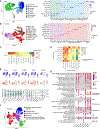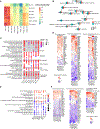Hofbauer cells and fetal brain microglia share transcriptional profiles and responses to maternal diet-induced obesity
- PMID: 38848212
- PMCID: PMC11808824
- DOI: 10.1016/j.celrep.2024.114326
Hofbauer cells and fetal brain microglia share transcriptional profiles and responses to maternal diet-induced obesity
Abstract
Maternal immune activation is associated with adverse offspring neurodevelopmental outcomes, many mediated by in utero microglial programming. As microglia remain inaccessible throughout development, identification of noninvasive biomarkers reflecting fetal brain microglial programming could permit screening and intervention. We used lineage tracing to demonstrate the shared ontogeny between fetal brain macrophages (microglia) and fetal placental macrophages (Hofbauer cells) in a mouse model of maternal diet-induced obesity, and single-cell RNA-seq to demonstrate shared transcriptional programs. Comparison with human datasets demonstrated conservation of placental resident macrophage signatures between mice and humans. Single-cell RNA-seq identified common alterations in fetal microglial and Hofbauer cell gene expression induced by maternal obesity, as well as sex differences in these alterations. We propose that Hofbauer cells, which are easily accessible at birth, provide insights into fetal brain microglial programs and may facilitate the early identification of offspring vulnerable to neurodevelopmental disorders.
Keywords: CP: Immunology; CP: Metabolism; Hofbauer cells; fetal programming; microglia; mouse; neuroimmune; obesity; sex differences; single-cell RNA sequencing.
Copyright © 2024 The Authors. Published by Elsevier Inc. All rights reserved.
Conflict of interest statement
Declaration of interests A.G.E. serves as a consultant for Mirvie, Inc. outside of this work. A.G.E. receives research funding from Merck Pharmaceuticals outside of this work. R.H.P. is a founder and member of the scientific advisory board of Psy Therapeutics; a member of scientific advisory boards for Swan AI Studio, Belle Artificial Intelligence, Genomind, and Circular Genomics; and consults to Alkermes, Burrage Capital, and Vault Health. He serves as an associate editor for JAMA Network Open. All of these roles are outside the present work.
Figures





Update of
-
Hofbauer cells and fetal brain microglia share transcriptional profiles and responses to maternal diet-induced obesity.bioRxiv [Preprint]. 2023 Dec 19:2023.12.16.571680. doi: 10.1101/2023.12.16.571680. bioRxiv. 2023. Update in: Cell Rep. 2024 Jun 25;43(6):114326. doi: 10.1016/j.celrep.2024.114326. PMID: 38187648 Free PMC article. Updated. Preprint.
Similar articles
-
Hofbauer cells and fetal brain microglia share transcriptional profiles and responses to maternal diet-induced obesity.bioRxiv [Preprint]. 2023 Dec 19:2023.12.16.571680. doi: 10.1101/2023.12.16.571680. bioRxiv. 2023. Update in: Cell Rep. 2024 Jun 25;43(6):114326. doi: 10.1016/j.celrep.2024.114326. PMID: 38187648 Free PMC article. Updated. Preprint.
-
Placental Macrophages: A Window Into Fetal Microglial Function in Maternal Obesity.Int J Dev Neurosci. 2019 Oct;77:60-68. doi: 10.1016/j.ijdevneu.2018.11.004. Epub 2018 Nov 20. Int J Dev Neurosci. 2019. PMID: 30465871 Free PMC article.
-
Maternal SARS-CoV-2 impacts fetal placental macrophage programs and placenta-derived microglial models of neurodevelopment.J Neuroinflammation. 2024 Jun 25;21(1):163. doi: 10.1186/s12974-024-03157-w. J Neuroinflammation. 2024. PMID: 38918792 Free PMC article.
-
Placental Macrophage (Hofbauer Cell) Responses to Infection During Pregnancy: A Systematic Scoping Review.Front Immunol. 2022 Feb 11;12:756035. doi: 10.3389/fimmu.2021.756035. eCollection 2021. Front Immunol. 2022. PMID: 35250964 Free PMC article.
-
Assessing in-vitro models for microglial development and fetal programming: a critical review.Front Immunol. 2025 Jan 29;16:1538920. doi: 10.3389/fimmu.2025.1538920. eCollection 2025. Front Immunol. 2025. PMID: 39944696 Free PMC article. Review.
Cited by
-
Vertical transmission of Leishmania donovani with placental degeneration in the pregnant mouse model of visceral leishmaniasis.PLoS Negl Trop Dis. 2025 Jun 9;19(6):e0012650. doi: 10.1371/journal.pntd.0012650. eCollection 2025 Jun. PLoS Negl Trop Dis. 2025. PMID: 40489555 Free PMC article.
-
Maternal stressors disrupt mouse placental proteome and fetal brain development in a sex-specific fashion through inflammation and oxidative stress.Mol Psychiatry. 2025 Jul 10. doi: 10.1038/s41380-025-03090-1. Online ahead of print. Mol Psychiatry. 2025. PMID: 40640553
-
Immune Responses to SARS-CoV-2 in Pregnancy: Implications for the Health of the Next Generation.J Immunol. 2022 Oct 15;209(8):1465-1473. doi: 10.4049/jimmunol.2200414. J Immunol. 2022. PMID: 36192115 Free PMC article. Review.
-
Developmental Programming of the Fetal Immune System by Maternal Western-Style Diet: Mechanisms and Implications for Disease Pathways in the Offspring.Int J Mol Sci. 2024 May 29;25(11):5951. doi: 10.3390/ijms25115951. Int J Mol Sci. 2024. PMID: 38892139 Free PMC article. Review.
-
Hypoxia in extravillous trophoblasts links maternal obesity and offspring neurobehavior.iScience. 2025 May 12;28(6):112636. doi: 10.1016/j.isci.2025.112636. eCollection 2025 Jun 20. iScience. 2025. PMID: 40502709 Free PMC article.
References
MeSH terms
Grants and funding
LinkOut - more resources
Full Text Sources
Molecular Biology Databases
Research Materials
Miscellaneous

